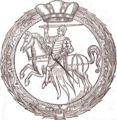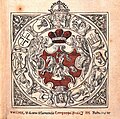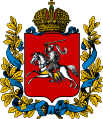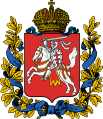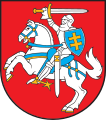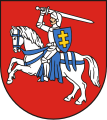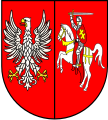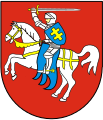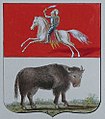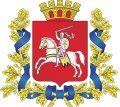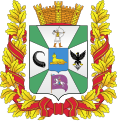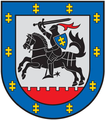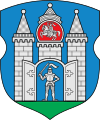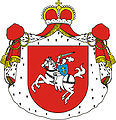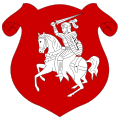Undid revision 1037581412 by Hugo.arg (talk) Per Wikipedia:Consensus reached at Talk:Pahonia#RFC: Pahonia (see RFC closing statement here: https://en.wikipedia.org/w/index.php?title=Talk:Pahonia&diff=1036948018&oldid=1035217824). Revert one more time and I'm reporting your disruptive actions at Wikipedia:Arbitration/Requests/Enforcement. It was clearly stated at RfC that disruptive behavior will result in blocking. Tags: New redirect Undo Reverted |
Kazimier Lachnovič (talk | contribs) Undid revision 1037582863 by Pofka (talk) Tags: Removed redirect Undo Reverted |
||
| Line 1: | Line 1: | ||
{{Use mdy dates|date=March 2016}} |
|||
#redirect [[Coat of arms of Lithuania]] |
|||
{{Infobox coat of arms |
|||
| name = Pogonia, Pogoń, Pahonia, Waikymas, Vytis |
|||
| image = Coat of arms of the Grand Duchy of Lithuania.svg |
|||
| image_width = 150 |
|||
| image2 = Coat of arms of Lithuania.svg |
|||
| image2_width = 100 |
|||
| image2_caption = [[Coat of arms of Lithuania|Vytis (Pogonia)]] ([[Lithuania]], 1991–present) |
|||
| image3 = Coat of arms of Belarus (1991–1995).svg |
|||
| image3_width = 100 |
|||
| image3_caption = [[National_emblem_of_Belarus#Pahonia|Пагоня]] ([[Belarus]], 1991–1995) |
|||
| image4 = POL COA Pogoń Ruska.svg |
|||
| image4_width = 100 |
|||
| image4_caption = [[Pogoń Ruska coat of arms|Pogon Ruska]] |
|||
| image5 = Coat_of_arms_of_Belarusian_People's_Republic.svg |
|||
| image5_width = 100 |
|||
| image5_caption = Coat of arms of [[Belarusian People's Republic]] |
|||
| image6 = POL COA Meszczeryn.svg |
|||
| image6_width = 100 |
|||
| image6_caption = Pogon Tatar |
|||
| image7 = POL COA Pogonia.svg |
|||
| image7_width = 100 |
|||
| image7_caption = [[Pogonia coat of arms|Pogonia]] |
|||
| armiger = |
|||
| year_adopted = |
|||
| crest = |
|||
| torse = |
|||
| shield = |
|||
| supporters = |
|||
| compartment = |
|||
| motto = |
|||
| orders = |
|||
| other_elements = |
|||
| earlier_versions = |
|||
| use = [[Grand Duchy of Lithuania]] (15th century–1795),<br /> [[Lithuania]] (1918–1940, 1990–present),<br /> [[Belarus]] (1991–1995)<br />[[Belarusian Democratic Republic]] (1918–present [in exile]) |
|||
}} |
|||
The '''Pahonia'''<ref>James B. Minahan. The Complete Guide to National Symbols and Emblems [2 volumes]. ABC-CLIO, 2009. P. [https://books.google.by/books?hl=ru&id=jfrWCQAAQBAJ&dq=pahonia+belarusian+emblem&q=pahonia#v=snippet&q=pahonia&f=false 329, 332, 970].</ref><ref>Astapienia R. The history of the Great Duchy of Lithuania: Belarus' Medieval Origins // The Journal of Belarusian Studies. 2014. p. [https://books.google.by/books?id=aOtDCwAAQBAJ&pg=PA108&dq=pahonia&hl=en 108].</ref><ref>Łatyszonek O. My ranking of European nations it the early 21st century // The Geopolitical Place of Belarus in Europe and the World. Fundacja Przestrzeni Obywat, 2006. p. [https://books.google.by/books?id=yJ-z7N1MNnsC&pg=PA167&dq=pahonia+belarus&hl=en 167]</ref> ({{lang-be|Пагоня|Pahonya}}, {{IPA-be|paˈɣonʲa|pron}}; {{lang-pl|Pogoń|lit=pursuit}}; {{lang-ua|Погоня|lit=pursuit}}; {{lang-lt|[[Vytis]]|lit=chase}}) is the historical coat of arms of the [[Grand Duchy of Lithuania]], one variation of which is the current [[coat of arms of Lithuania]], and the traditional national coat of arms of [[Belarusians]].<ref name="EBH">Энцыклапедыя гісторыі Беларусі. У 6 т. Т. 1: А — Беліца / Беларус. Энцыкл.; Рэдкал.: М. В. Біч і інш.; Прадм. М. Ткачова; Маст. Э. Э. Жакевіч. — Менск: БелЭн, 1993. — 494 с., [8] к.: іл. ISBN 5-85700-074-2. С. 391.</ref> From the main colors of Pahonia, which are Belarusian national colors, the historical national [[Flag of Belarus#White-red-white flag|White-red-white flag]] is originated.<ref name="EBH"/> It was also the official emblem of the [[Belarusian Democratic Republic]] in 1918 and of the [[Republic of Belarus]] from 1991 to 1995. It also is today the emblem of several towns and cities in Belarus, Lithuania and Poland. |
|||
On May 14, 2007 the Pahonia was declared [[cultural heritage of Belarus]].<ref>{{Cite web|url=http://spadchina.by/postanovlenie-soveta-ministrov-respubliki-belarus-ot-14.05.2007-%E2%84%96-578-%C2%ABab-statuse-gistoryika-kulturnyix-kashto%D1%9Enasczej%C2%BB.html|title=Постановление Совета Министров Республики Беларусь от 14.05.2007 № 578 «Аб статусе гiсторыка-культурных каштоўнасцей»|website=spadchina.by}}</ref> |
|||
<!--- Wikipedia:Consensus was reached at Talk:Pahonia#RFC:Pahonia (see: https://en.wikipedia.org/wiki/Talk:Pahonia#RFC:_Pahonia) that this article should be remade into a redirect page to article Coat of arms of Lithuania. The request for comment was closed on 3 August 2021 (see: https://en.wikipedia.org/w/index.php?title=Talk:Pahonia&diff=1036948018&oldid=1035217824). Consequently, any attempts to deny Wikipedia:Consensus or any other malicious activity will result in a report to the Wikipedia:Arbitration/Requests/Enforcement and serious sanctions (blocking) afterwards. Respect the Wikipedia:Policies and guidelines and Wikipedia:Assume good faith. ---> |
|||
== Origins == |
|||
The origins of the coat of arms of Pahonia goes back centuries and has a [[Semantics|semantic]] connection with the ancient military tradition of folk chase — the most important function of the organization of life and life of the [[East Slavic people|East Slavic tribes]] when everyone was responsible for the life of a fellow tribesman.<ref name="EBH"/> In the event of a sudden attack by the enemy and the capture of relatives, every man who had the [[Right to keep and bear arms|right to bear arms]] had to [[Withdrawal (military)|flee]] on foot or on [[Equestrianism|horseback]] in pursuit of the enemy to repel.<ref name="EBH"/>{{Better source needed|date=June 2021|Non-online source published in an authoritarian state, which is run by a dictator fails Wikipedia:Reliable sources and Wikipedia:Verifiability; neutral, online source is required to support such statements}}{{Dubious|date=June 2021|Non-online source published in an authoritarian state, which is run by a dictator fails Wikipedia:Reliable sources and Wikipedia:Verifiability; neutral, online source is required to support such statements}} In the conditions of military [[democracy]], the tradition of popular [[persecution]] was unconditionally observed and preserved for centuries both in the epoch of [[Kievan Rus']] and in the times of the [[Grand Duchy of Lithuania]].<ref name="EBH"/> |
|||
The official Belarusian name Pahonia (in old spelling ″Pogonia″) leaves no doubt about the ethnicity of the society in which the coat of arms of the Grand Duchy of Lithuania appeared and was used.<ref>Шаланда А. Кароткі нарыс гісторыі беларускай нацыянальнай і дзяржаўнай сімволікі // Герольд Litherland. № 21, 2019. С. 5.</ref>{{Better source needed|date=June 2021|Non-online source published in an authoritarian state, which is run by a dictator fails Wikipedia:Reliable sources and Wikipedia:Verifiability; neutral, online source is required to support such statements}}{{Dubious|date=June 2021|Non-online source published in an authoritarian state, which is run by a dictator fails Wikipedia:Reliable sources and Wikipedia:Verifiability; neutral, online source is required to support such statements}} At the same time, the using of coat of arms with Pahonia fall mostly on {{ill|the ethnic territory of Belarusians|be|Этнічная тэрыторыя беларусаў}}.<ref>Цітоў А. Наш сімвал — Пагоня: Шлях праз стагоддзі. — Менск: Полымя, 1993. — 40 с.: іл. ISBN 5-345-00740-3. P. 25—26.</ref><ref>Арлоў У., Герасімовіч З. Краіна Беларусь. Вялікае Княства Літоўскае / Рэц. А. Грыцкевіч, У. Ляхоўскі; рэд. З. Санько; картограф В. Цемушаў. — KALLIGRAM, spol s r.o., 2012. — 400 с. : іл. ISBN 978-985-6919-82-7. P. 100.</ref>{{Better source needed|date=June 2021|Non-online source published in an authoritarian state, which is run by a dictator fails Wikipedia:Reliable sources and Wikipedia:Verifiability; neutral, online source is required to support such statements}}{{Dubious|date=June 2021|Non-online source published in an authoritarian state, which is run by a dictator fails Wikipedia:Reliable sources and Wikipedia:Verifiability; neutral, online source is required to support such statements}} |
|||
==History== |
|||
===Grand Duchy of Lithuania=== |
|||
[[File:Pieczec wielka litewska Stanislawa Augusta 1764.png|thumb|left|State emblem on the large Lithuanian seal of the last Grand Duke of Lithuania [[Stanisław August Poniatowski]]]] |
|||
The charging [[knight]] first emerged as a state emblem in the region in 1329 on the seal of duke [[Aleksandr Mikhailovich of Tver|Alexander Michailovich]] of [[Pskov]].<ref>{{Cite web|url=http://www.arche.by/by/page/reviews/15682|archiveurl=https://web.archive.org/web/20140202144845/http://www.arche.by/by/page/reviews/15682|url-status= dead|title=About a question of aspects of the foundation of Great Duchy of Lithuania (second part)|archivedate=February 2, 2014}}</ref> He was the deputy of [[Gediminas]] of Lithuania to [[Pskov]] which was a part of [[Grand Duchy of Lithuania]] at that time. At the same time, duke [[Narimantas]] of [[Polotsk]] used Pahonia on his seal as well.<ref>{{Cite web|url=http://pawet.net/library/history/bel_history/_articles/kazbiaruk/%D0%9A%D0%B0%D0%B7%D0%B1%D1%8F%D1%80%D1%83%D0%BA_%D0%A3._%D0%9B%D0%B5%D1%82%D0%B0%D0%BF%D1%96%D1%81%D1%8B_%D0%BF%D1%80%D0%B0_%D0%BD%D0%B0%D1%80%D0%B0%D0%B4%D0%B6%D1%8D%D0%BD%D0%BD%D0%B5_%D0%9F%D0%B0%D0%B3%D0%BE%D0%BD%D1%96.html|title=Pawet: Казбярук У. Летапісы пра нараджэнне Пагоні|website=pawet.net|trans-title=Pawet: Kazbiaruk W. Annals of the birth of Pahoni}}</ref> These facts illustrate that it is the most probable that Pahonia was already in use as a state symbol of Lithuania at least in 1329. However, by [[Gustyn Chronicle]] duke [[Vytenis]] of Lithuania (1293–1316) "began ruling on Lithuania and designed a coat of arms and a seal for himself and for Lithuania: armed knight riding on a horse; this symbol at present time is called Pahonia" (quote by "Chronicles about Pahonia's birth"). |
|||
The symbol of the charging knight on horseback passed down through the generations: from [[Algirdas]] to his son, Grand Duke [[Jogaila]] (ruled 1377 – 1392), then to Grand Duke [[Vytautas]] (ruled 1392 – 1430) and to others. By the 14th century, the charging knight on horseback with a sword had begun to feature in a heraldic shield, first in Jogaila's seal in 1386 or 1387, and also in the seal of Vytautas in 1401. As early as the 15th century, the heraldic charging knight on horseback became the [[coat of arms]] of the [[Grand Duchy of Lithuania]] and of its central part – the [[Duchy of Lithuania]]. 16th-century documents refer to it using the Polish term ''Pogoń''. At first, the charging knight might appear riding either left or right; and sometimes he held a lance. But as of the first half of the 15th century, all depictions show him riding towards the left (as seen by the viewer), with a sword in his raised hand and a shield in the left hand. |
|||
<gallery> |
|||
File:Печать Наримунта (Глеба) Полоцкого, 1330.svg|Seal of [[Narimantas]], Prince of [[Polotsk]], 1338 |
|||
File:Lob Печать Лугвена Ольгердовича.svg|Seal of [[Lengvenis]], ruler of [[Novgorod Republic|Great Novgorod Republic]], 1395 |
|||
File:Lob Погоня Сигизмунда Кейстутовича.svg|Seal of [[Sigismund Kęstutaitis]] in 1432 |
|||
File:Codex Bergshammar - GDL 1.png|Coat of arms of Lithuania redrawn from the Codex Bergshammar. About 1435 |
|||
File:Jagajła, Pahonia. Ягайла, Пагоня (K. Kielisiński, 1841).jpg|Coat of arms "Pagonya" from the tombstone of [[Władysław II Jagiełło|Jagiełło]], 15th century |
|||
File:Coat of arms of the Grand Duchy of Lithuania.svg|An appearance of the coat of arms in the mid-16th century |
|||
File:Pahonia_-_Пагоня,_Grand_Duchy_of_Lithuania_COA_(1575)_cut.png|Coat of arms in 1575 |
|||
File:Žygimont Aŭgust, Pahonia. Жыгімонт Аўгуст, Пагоня crop.png|Coat of arms of the Polish–Lithuanian Commonwealth |
|||
File:COA of the Grand Duchy of Lithuania 1588.png|The Pahonia as depicted on the [[Statutes of Lithuania|Statute of the Grand Duchy of Lithuania]], 1588 |
|||
File:Statut Vialikaha Kniastva Litoŭskaha, Pahonia. Статут Вялікага Княства Літоўскага, Пагоня (1614).jpg|The Pahonia as depicted on the [[Statutes of Lithuania|Statute of the Grand Duchy of Lithuania]], 1614 |
|||
</gallery> |
|||
In the 15th century, the colors of the seal became uniform. The livery colors became fixed: a white (silver) charging knight on a red field of the heraldic shield. The charging knight at this time bore a blue shield, and set against the blue field appeared a double (gold) cross. The coat of arms featured the Grand Duke's headgear on the crest. |
|||
At first, the charging knight showed the figure of the ruler of the country, but with time it came to be understood and interpreted as that of a riding knight chasing an intruder out of his native country. Such an understanding became especially popular in the 19th century and in the first half of the 20th century. The explanation has a sound historical foundation. We know that at the [[Battle of Grunwald]] (1410), where the united Polish–Lithuanian army crushed the army of the [[Teutonic Knights]] (thus putting an end to the Knights' eastward expansion) thirty Lithuanian and Ruthenian regiments out of a total of forty fought under banners flying the sign of the Pahonia. |
|||
With minor stylistic changes, the Pahonia coat of arms remained the state symbol of the Grand Duchy of Lithuania until 1795, when the [[Russian Empire]] annexed and extinguished the Polish–Lithuanian Commonwealth in the Third Partition of Poland. |
|||
=== Russian Empire === |
|||
[[File:Герб Княжества и области белорусские и литовские 1882.svg|thumb|Coat of arms of the principalities and regions of Belarus and Lithuania on the coat of arms of the Russian Empire. 1882]] |
|||
<gallery> |
|||
File:Vilnia, Antokal, Pahonia. Вільня, Антокаль, Пагоня (K. Bachmatovič, 1837).jpg|The Pahonia on the White Columns of Vilnius (1818–1840) |
|||
File:Viciebsk, Pahonia. Віцебск, Пагоня (1781).jpg|Coat of arms of [[Vitebsk]], 1781 |
|||
File:Coat of arms of Polotsk 1781 (2).svg|Coat of arms of [[Polotsk]] Viceroyalty, 1781 |
|||
File:Coat of arms of Vierchniadzvinsk 1781.svg|Coat of arms of [[Verkhnyadzvinsk]], 1781 |
|||
File:Coat of arms of Gorodok 1781.svg|Coat of arms of [[Haradok]], 1781 |
|||
File:Coat of arms of Dvinsk 1781.svg|Coat of arms of [[Daugavpils|Dvinsk]], 1781 |
|||
File:Coat of arms of Lucin 1781.svg|Coat of arms of [[Ludza|Lucina]], 1781 |
|||
File:Coat of arms of Nevel 1781.svg|Coat of arms of [[Nevel (town)]], 1781 |
|||
File:Coat of arms of Rezhitsa 1781.svg|Coat of arms of [[Rēzekne|Rezhitsa]], 1781 |
|||
File:Coat of arms of Sebezh 1781.svg|Coat of arms of [[Sebezh]], 1781 |
|||
File:Coat of arms of Surazh 1781.svg|Coat of arms of [[Surazh, Belarus|Surazh]], 1781 |
|||
File:Coat of arms of Mogilev 1781.svg|Coat of arms of [[Mogilev]], 1781 |
|||
File:Coat of arms of Liepieĺ 1852.png|Coat of arms of [[Lyepyel]], 1852 |
|||
File:Vilnius COA 1845.png|Coat of arms of [[Vilnius|Vilna]], 1845 |
|||
File:Coat of arms of Vitebsk Governorate 1856.svg|Coat of arms of [[Vitebsk Governorate]]. 1856 |
|||
File:Coat of arms of Vilna Governorate 1878.svg|Coat of arms of [[Vilna Governorate]]. 1878 |
|||
File:Principality of Vitebsk.gif|Principality of Vitebsk. Coat of Arms. 1906 |
|||
File:Principality of Polotsk.jpg|Principality of Polotsk. Coat of Arms. 1906 |
|||
</gallery> |
|||
Following the partition of the [[Polish–Lithuanian Commonwealth]], most of the [[Grand Duchy of Lithuania]] was absorbed by the [[Russian Empire]] and the Pahonia was incorporated into the imperial state emblem. After the [[first partition of Poland]] and Lithuania, [[Catherine II the Great|Catherine the Great]] gave the Pahonia coat of arms to several towns in the newly acquired ethnic [[Belarusians|Belarusian]] and [[Latgallians|Latgallian]] territories, including [[Daugavpils]], [[Ludza]], [[Sebezh]], [[Polacak]], [[Nevel (town)|Nevel]], [[Haradok]], [[Viciebsk]], [[Surazh, Belarus|Surazh]], [[Velizh]].The motive for this was that this territory once belonged to the Grand Duchy of Lithuania. |
|||
The Pahonia was the coat of arms of the [[Vilna Governorate]] following the incorporation of [[Vilnius]] and surrounding lands into the [[Russian Empire]]. Pahonia statues placed on white columns greeted visitors at the entrances to the city from 1818 until 1840, when the statues were replaced with two-headed eagles – the state symbol of the [[Russian Empire]]. |
|||
Uprisings to restore the [[Polish–Lithuanian Commonwealth]] like the 1830–31 [[November Uprising]] and 1863–64 [[January Uprising]] saw the Pahonia used as a symbol of rebellion against the [[Russian Empire]]. |
|||
During the 19th century [[Lithuanian National Revival]], [[Simonas Daukantas]] introduced the term ''wytis'' in reference to the Pahonia for the first time in a historical work on Lithuanian culture called ''Budą Senowęs Lietuwiû kalneniu ir Żemaitiû'' (1846). The etymology of this particular name is not universally accepted; it is either a direct translation of the Polish ''Pogoń'', a common noun constructed from the Lithuanian verb ''vyti'' ("to chase") or, less likely, a derivative from the [[East Slavic peoples|East Slavic]] title of the knight, ''vytiaz'''. The earliest known Lithuanian name for the symbol is a 17th-century translation of ''Pogonia'' by [[Konstantinas Sirvydas]] as ''Waikimas'' ("Vaikymas", according to contemporary Lithuanian spelling), which was used until the 19th century together with ''Pagaunia'' (in Lithuanian, "pagauti" means "to catch").<ref name="rimsa2">Lietuviškoje XVIIIa. pabaigos – XIXa. literatūroje valstybės herbas, galima sakyti, vadintas tik Vaikymu, kuris neabejotinai yra lenkiškojo Pogonia atitikmuo</ref> |
|||
=== Belarusian Democratic Republic === |
|||
The Pahonia appeared on the state seal of the [[Belarusian Democratic Republic]] for a short period between 1918 and 1919. [[West Belarus]] became part of interwar Poland, and the Pahonia was used as the symbol of several provinces of the former Grand Duchy of Lithuania, namely the [[Polesie Voivodeship]], the [[Wilno Voivodeship (1923–1939)|Wilno Voivodeship]], and the [[Nowogródek Voivodeship (1919–1939)|Nowogródek Voivodeship]]. It was also used by West Belarusian separatist organizations. |
|||
<gallery> |
|||
File:Герб БНР 1918.svg|The Pahonia as used in the [[Belarusian Democratic Republic]] in 1918 |
|||
File:Stamp pahonia 1918.png|Coat of arms from the [[Belarusian Democratic Republic|BDR]] stamp. 1918 |
|||
File:Pahonia, BNR. Пагоня, БНР (1918-20).jpg|Passport of the Belarusian Democratic Republic, 1918-1919 |
|||
File:Diplomatic mission of BNR.jpg|Sign of a Belarusian diplomatic mission in late 1910s - early 1920s |
|||
File:Słucak, Pahonia. Слуцак, Пагоня (1920).jpg|Flag of the 1st Slutsk Regiment during the [[Slutsk Defence Action]], 1920 |
|||
</gallery> |
|||
=== Republic of Lithuania in the Interwar === |
|||
It was the national coat of arms of the independent [[Republic of Lithuania]] (1918–1940) until the country was forcibly annexed by the Soviet Union in 1940. |
|||
<gallery> |
|||
File:Vytis (Pogonia) by Tadas Daugirdas.jpg|''Vytis'' (''Pogonia''), designed in 1918 by [[Tadas Daugirdas]] |
|||
File:Older version of Lithuania COA.png|[[Juozas Zikaras]]' design, used on coins of the interwar [[Republic of Lithuania]] |
|||
File:Coat of arms of Lithuania (1920).png|Interwar [[Republic of Lithuania]] |
|||
</gallery> |
|||
=== World War II === |
|||
During World War II, the [[Byelorussian Central Council]], the Nazi collaborationist regimes, also used the symbol. |
|||
=== Soviet Union === |
|||
During Soviet times the use of the emblem was illegal. It was used only by Belarusian and Lithuanian emigre communities in the USA, Canada, and elsewhere. [[File:Coat of arms of Belarus (1918, 1991-1995).svg|thumb|right|100px|Coat of arms of the Republic of Belarus in 1991–1995]] |
|||
===1990–present=== |
|||
[[File:Pahonia in Viciebsk.jpg|thumb|Pahonia on the building of the Vitebsk State Academy of Veterinary Medicine]] |
|||
In the late 1980s, during a new wave of Belarusian national rebirth, the [[Belarusian Popular Front]] adopted the Pahonia as its emblem, despite the fact that its public display constituted a criminal offense in the [[Soviet Union]].{{Citation needed|date=October 2008}} Variants were used by Lithuania's independence movement during the [[perestroika]] period. Its use was legalised by Lithuania's Soviet authorities in 1988. |
|||
On 11 March 1990, Lithuania declared independence from the [[Soviet Union]] and restored all of its pre-World War II state symbols, including the historic coat of arms. On September 4, 1991, a new design by [[Arvydas Každailis]] was approved based on recommendations of a special heraldic committee. The new design replaced interwar versions, harkening back to earlier variants used by the [[Grand Duchy of Lithuania]]. It re-established its original colors but placed the horse and rider in an ostensibly more "defensive" posture, [[airs above the ground]] rather than leaping forward and sword simply elevated rather than ready to strike. |
|||
[[File:Presidential Palace (9654548066).jpg|thumb|The Pahonia as depicted on Lithuania's [[Presidential Palace, Vilnius|Presidential Palace]].]] |
|||
In 1991, after the [[dissolution of the Soviet Union]], the Pahonia became the coat of arms of the independent [[Republic of Belarus]]. The official design of the 1991 coat of arms of Belarus was created by a team of artists led by [[Jauhien Kulik]] and [[Uladzimir Krukouski]] basing on various Medieval designs of the Pahonia as the coat of arms of the [[Grand Duchy of Lithuania]].<ref>{{Cite web|url=https://www.svaboda.org/a/26949275.html|title=Крукоўскі паказаў «канструктар», паводле якога малявалася «Пагоня» ВІДЭА|website=Радыё Свабода}}</ref><ref>{{Cite web|url=https://euroradio.fm/yak-stvarali-gerb-pagonya-fota|title=Як стваралі герб “Пагоня” (фота)|website=Навіны Беларусі | euroradio.fm}}</ref> |
|||
<gallery> |
|||
File:Belarus-1992-Bill-0.5-Reverse.jpg|[[Belarusian ruble#History|Payment coupon]] of the National Bank of Belarus, 1992, 50 [[kapiejka]]s ([[Belarusian ruble|kopeck]]s), reverse |
|||
File:Belarusian Passport (cover).jpg|Belarusian passport, 1991-1995 |
|||
File:Constitution of Belarus 1994 1.jpg|Constitution of Belarus, 1994 |
|||
File:Coat of arms of Lithuania.svg|"[[Airs above the ground]]": the contemporary, "defensive" coat of arms of the [[Republic of Lithuania]] by [[Arvydas Každailis]] (official since 1991) |
|||
File:Flag of Belarus (w-r-w) with Arms (2020).svg|White-red-white flag of Belarus [[Defacement (flag)|defaced]] with the Pahonia coat of arms |
|||
File:Banner of the Pahonia coat of arms of Belarus.png|Heraldic banner of the Belarusian Pahonia coat of arms |
|||
</gallery>[[FIle:Demonstration against Alexander Lukashenko in front of the Belarus Embassy in Moscow. (2020-08-23) 18.jpg|thumb|[[Pahonia]] on display as it is widely used during [[2020–21 Belarusian protests]]|left]]In 1995, following a [[1995 Belarusian referendum|controversial referendum]], [[Alexander Lukashenko]] scrapped the Pahonia's status as the official coat of arms and replaced it with a [[National emblem of Belarus|modified Soviet emblem]]. Since then the Pahonia has served as one of the symbols of the anti-Lukashenko [[Opposition (politics)|opposition]] in Belarus. |
|||
In 2004, Lithuania's [[Seimas]] confirmed a historical flag of Lithuania depicting the Pahonia on a rectangular red background, recalling the old battle flags of the [[Grand Duchy of Lithuania]]. The flag does not replace the yellow-green-red tri-color [[national flag]] [[Flag of Lithuania|of Lithuania]]. It is used on special occasions and in buildings of historic significance. |
|||
It is currently proposed that a larger version of the coat of arms be adopted. It would feature a line from "[[Tautiška giesmė]]", the national anthem of Lithuania, "Vienybė težydi" ("May unity blossom"). The [[Seimas]] already uses a larger version of the coat of arms with this phrase as its [[motto]], along with two [[supporter]]s: the dexter one a [[griffin]] argent beaked and membered or, langued gules, and the sinister one a [[unicorn]] argent, armed and unguled or, langued gules, and the ducal hat on top of the shield. The [[List of rulers of Lithuania|President of Lithuania]] uses the shield and supporters only. |
|||
[[Lithuania]] joined the [[Eurozone]] by adopting the euro on 1 January 2015.<ref>[https://www.consilium.europa.eu/en/homepage/highlights/lithuania-adopts-the-euro/?lang=en Lithuania adopts the Euro] {{Dead link|date=August 2020|fix-attempted=yes}}</ref> The designs of [[Lithuania and the euro|Lithuanian euro coins]] share a similar national side for all denominations, featuring the [[Vytis]] and the name of the country, "Lietuva". The design was announced on 11 November 2004 following a public opinion poll conducted by the [[Bank of Lithuania]]. The horse is again leaping forward, as in more traditional versions. |
|||
<gallery> |
|||
File:N22978_2_eur_aversas.jpg|[[Lithuania and the euro|Lithuanian euro]] coin, obverse side |
|||
File:Flag of Lithuania (state).svg|The historical state flag of Lithuania, official since 2004 |
|||
</gallery> |
|||
==Pahonia as a regional coat of arms== |
|||
The Pahonia is a feature of many emblems of cities and provinces of the former [[Grand Duchy of Lithuania]] and [[Polish–Lithuanian Commonwealth]].<ref>{{Cite web |url=http://www.geocities.com/heraldica_litvaniae/regijony/vajvodships.html |title=Middle Age Provinces of Litva |access-date=June 27, 2009 |archive-date=October 25, 2009 |archive-url=https://www.webcitation.org/query?url=http://www.geocities.com/heraldica_litvaniae/regijony/vajvodships.html&date=2009-10-25+23:55:45 |url-status=bot: unknown }}</ref> |
|||
<gallery> |
|||
File:POL województwo nowogródzkie II RP COA.svg|[[Nowogródek Voivodeship (1919–1939)|Nowogródek Voivodeship]] |
|||
File:POL województwo wileńskie II RP COA.svg|Vilnius/[[Wilno Voivodeship (1923–1939)|Wilno Voivodeship]] (annexed by Poland from 1926–1939) |
|||
File:POL województwo poleskie II RP COA.svg|[[Polesie Voivodeship]] |
|||
File:POL województwo białostockie II RP COA.svg|[[Białystok Voivodeship (1919–1939)|Białystok Voivodeship]] and [[Podlaskie Voivodeship (1513–1795)]] |
|||
File:POL Mińskie COA.svg|[[Minsk Voivodeship]] |
|||
File:Coat of Arms of Połacak Voivodeship.svg|[[Polock Voivodeship]] |
|||
File:Coat of Arms of Viciebsk Voivodeship.svg|[[Witebsk Voivodeship]] |
|||
File:Banner of Amścisłaŭ Voivodeship.svg|Banner of the [[Mstsislaw Voivodeship]] |
|||
</gallery> |
|||
After the annexation of the Grand Duchy of Lithuania to the Russian Empire, the [[Polotsk]], [[Vitebsk]] and [[Vilno]] governorates inherited coats of arms of their former voivodeships. |
|||
<gallery> |
|||
File:Coat of arms of Polotsk 1781 (2).svg|Polotsk Governorate coat of arms. 1781 |
|||
File:Horadnia, Pahonia. Горадня, Пагоня (1843).jpg|[[Grodno Governorate]] coat of arms. 1802 |
|||
File:Coat of arms of Vitebsk Governorate 1856.svg|[[Vitebsk Governorate]] coat of arms. 1856 |
|||
File:Coat of arms of Vilna Governorate 1878.svg|[[Vilna Governorate]] coat of arms. 1878 |
|||
</gallery> |
|||
Pahonia is the official emblem of the [[Vitebsk Region|Vitsebsk voblast]] and part of the official emblem of the [[Gomel Region|Homyel voblast]]. |
|||
<gallery> |
|||
File:Coat of Arms of Vitsebsk Voblasts.svg|[[Vitebsk Region|Vitsebsk voblast]] coat of arms |
|||
File:Coat of arms of Homyel Voblast.svg|[[Gomel Region|Homyel voblast]] coat of arms |
|||
</gallery> |
|||
Pahonia (Vytis) is the official emblem of [[Vilnius County]] and [[Panevėžys County]] in modern Lithuania. |
|||
<gallery> |
|||
File:Vilnius_County_COA.png|[[Vilnius County]] coat of arms |
|||
File:Panevezys_County_COA.png|[[Panevėžys County]] coat of arms |
|||
</gallery> |
|||
Pohonia is part of coat of arms of [[Zhytomyr Oblast]] in Ukraine. |
|||
<gallery> |
|||
File:Coat of Arms of Zhytomyr Oblast.png|[[Zhytomyr Oblast]] coat of arms |
|||
</gallery> |
|||
===Appearances on urban coats of arms=== |
|||
While being part of the [[Grand Duchy of Lithuania]], some towns in Lithuania, Poland, Russia, Ukraine, Belarus (notably [[Vitebsk]], [[Haradok]], [[Polotsk]] and others) adopted the Pahonia as part of their [[Coat of Arms|coats of arms]]. Some of them continue usage of the coats today: |
|||
<gallery> |
|||
File:Coat of Arms of Lepiel, Belarus.svg|[[Lepiel]] |
|||
File:Coat of Arms of Vierchniadzvinsk, Belarus.svg|[[Verkhnyadzvinsk]] |
|||
File:Coat of Arms of Vilejka, Belarus, 1845.png|[[Vileyka]] (former coat of arms from 1845) |
|||
File:Coat of Arms of Lida, Belarus, 1845.png|[[Lida]] (former coat of arms from 1845) |
|||
File:Coat of Arms of Nevel (Pskov oblast).png|[[Nevel (town)|Nevel]], today part of [[Pskov Oblast]] of Russia |
|||
File:Velizh gerb.jpg|[[Velizh]], today part of [[Smolensk Oblast]] of Russia |
|||
File:POL Brańsk COA.svg|[[Brańsk]], today part of [[Podlaskie Voivodeship]] of [[Poland]] |
|||
File:Puławy herb.svg|[[Puławy]], in [[Poland]] |
|||
File:Herb Siedlce.svg|[[Siedlce]], in Poland |
|||
File:POL Drohiczyn COA.svg|[[Drohiczyn]], in Poland |
|||
File:Liudvinavas.gif|[[Liudvinavas]], in Lithuania |
|||
</gallery> |
|||
[[Rechytsa]], [[Mahiloŭ]] and several other cities have historically had the Pahonia as part of their city coat of arms: |
|||
<gallery> |
|||
File:Coat of Arms of Rečyca, Belarus.svg|[[Rechytsa]] |
|||
File:Coat of Arms of Mahiloŭ, Belarus.svg|[[Mahiloŭ]] |
|||
File:BIA Lipniszki COA.png|[[Lipnishki]] |
|||
File:Coat of arms of Iziaslav.png|[[Iziaslav, Ukraine|Iziaslav]] |
|||
</gallery> |
|||
==Pahonia as a political symbol== |
|||
Pahonia/Pogoń has been used by several political movements on the territory of the former [[Grand Duchy of Lithuania]] and in present-day Belarus |
|||
<gallery> |
|||
File:Coat_of_arms_of_the_January_Uprising.svg|Emblem of the [[January Uprising]] |
|||
</gallery> |
|||
==Other usage== |
|||
Pahonia is part of the emblems of several organizations in Belarus, including the [[World Association of Belarusians]], the [[Frantsishak Skaryna Belarusian Language Society]], the [[Union of Poles of Belarus]] as well as the [[BelaPAN]] news agency.<ref>{{Cite web|url=http://belapan.com/|title=БелаПАН. Главная|website=belapan.com|trans-title=BelaPAN. home}}</ref> |
|||
==Design and variations== |
|||
===Belarus (Pahonia)=== |
|||
The heraldic [[shield]] features a red field with an armored [[knight]] on a white (silver) horse holding a silver [[sword]] in his right hand above his head. A silver shield hangs on the left shoulder of the charging [[knight]], and a golden (yellow) [[Patriarchal cross]] appears on the shield. |
|||
===Kingdom of Rus=== |
|||
[[File:Alex K Halych-Volhynia.svg|50px|left]] |
|||
The rider carries a shield with the golden lion. |
|||
{{clearleft}} |
|||
===Lithuania (Vytis)=== |
|||
[[File:COA family pl Jagiellon.svg|50px|left]] |
|||
The main variation is a shield with the [[Jagiellonian dynasty]] coat of arms. The rider with Jagiellonian cross was popular in the [[Polish–Lithuanian Commonwealth]] and adopted for many of its voivodeships. |
|||
Gules, a knight armed cap-à-pie mounted on a horse salient argent, brandishing a sword proper and maintaining a shield azure charged with a cross of Lorraine Or. |
|||
{{clearleft}} |
|||
===Grand Duchy of Lithuania (Pahonya)=== |
|||
[[File:COA of Gediminaičiai dynasty Lithuania.svg|50px|left]] |
|||
The rider carries a shield with the [[columns of Gediminas]]. |
|||
{{clearleft}} |
|||
===Ostrogski family=== |
|||
[[File:Alex K Ostorzhskyi-3.svg|50px|left]] |
|||
Sometimes the rider may carry no shield at all. |
|||
{{clearleft}} |
|||
===Other variations=== |
|||
<gallery> |
|||
File:Coat of Arms of Mscisłaŭ, Belarus, 1634.png|Minor Pogon |
|||
File:Herb Pogon Litewska.jpg|[[Pogoń Litewska]] |
|||
POL COA Pogonia.svg|Pogon Polska ([[Pogonia coat of arms|Pogonia]]) |
|||
File:POL COA Meszczeryn.svg|Pogon Tatar |
|||
File:Coat of arms of Belarusian People's Republic.svg|Coat of arms of Belarusian People's Republic |
|||
</gallery> |
|||
==See also== |
|||
*[[Coat of arms of the Polish–Lithuanian Commonwealth]] |
|||
*[[Coat of arms of Lithuania]] (Vytis) |
|||
==References== |
|||
{{reflist}} |
|||
==External links== |
|||
*{{commonscat-inline}} |
|||
* [https://web.archive.org/web/20080510122312/http://www.gerb.bel.ru/pages/strani/belorus_91_2.htm The comparison of symbols of Lithuania and the Muscovite Ruthenia] {{in lang|ru}} |
|||
* [http://belarusdigest.com/2010/03/06/national-symbols-in-belarus-the-past-and-present National Symbols In Belarus: The Past And Present] {{Webarchive|url=https://web.archive.org/web/20161226211839/http://belarusdigest.com/2010/03/06/national-symbols-in-belarus-the-past-and-present |date=December 26, 2016 }} |
|||
[[Category:Belarusian coats of arms]] |
|||
[[Category:Cultural heritage of Belarus]] |
|||
[[Category:National symbols of Belarus]] |
|||
[[Category:Heraldic charges]] |
|||
[[Category:Coats of arms with swords]] |
|||
[[Category:Coats of arms with horses]] |
|||
[[Category:Coats of arms with crosses]] |
|||
Revision as of 14:59, 7 August 2021
| Pogonia, Pogoń, Pahonia, Waikymas, Vytis | |
|---|---|
 | |
| Versions | |
 Vytis (Pogonia) (Lithuania, 1991–present) | |
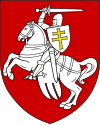 | |
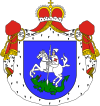 | |
| Use | Grand Duchy of Lithuania (15th century–1795), Lithuania (1918–1940, 1990–present), Belarus (1991–1995) Belarusian Democratic Republic (1918–present [in exile]) |
The Pahonia[1][2][3] (Belarusian: Пагоня, romanized: Pahonya, pronounced [paˈɣonʲa]; Polish: Pogoń, lit. 'pursuit'; Ukrainian: Погоня, lit. 'pursuit'; Lithuanian: Vytis, lit. 'chase') is the historical coat of arms of the Grand Duchy of Lithuania, one variation of which is the current coat of arms of Lithuania, and the traditional national coat of arms of Belarusians.[4] From the main colors of Pahonia, which are Belarusian national colors, the historical national White-red-white flag is originated.[4] It was also the official emblem of the Belarusian Democratic Republic in 1918 and of the Republic of Belarus from 1991 to 1995. It also is today the emblem of several towns and cities in Belarus, Lithuania and Poland.
On May 14, 2007 the Pahonia was declared cultural heritage of Belarus.[5]
Origins
The origins of the coat of arms of Pahonia goes back centuries and has a semantic connection with the ancient military tradition of folk chase — the most important function of the organization of life and life of the East Slavic tribes when everyone was responsible for the life of a fellow tribesman.[4] In the event of a sudden attack by the enemy and the capture of relatives, every man who had the right to bear arms had to flee on foot or on horseback in pursuit of the enemy to repel.[4][better source needed][dubious ] In the conditions of military democracy, the tradition of popular persecution was unconditionally observed and preserved for centuries both in the epoch of Kievan Rus' and in the times of the Grand Duchy of Lithuania.[4]
The official Belarusian name Pahonia (in old spelling ″Pogonia″) leaves no doubt about the ethnicity of the society in which the coat of arms of the Grand Duchy of Lithuania appeared and was used.[6][better source needed][dubious ] At the same time, the using of coat of arms with Pahonia fall mostly on the ethnic territory of Belarusians.[7][8][better source needed][dubious ]
History
Grand Duchy of Lithuania

The charging knight first emerged as a state emblem in the region in 1329 on the seal of duke Alexander Michailovich of Pskov.[9] He was the deputy of Gediminas of Lithuania to Pskov which was a part of Grand Duchy of Lithuania at that time. At the same time, duke Narimantas of Polotsk used Pahonia on his seal as well.[10] These facts illustrate that it is the most probable that Pahonia was already in use as a state symbol of Lithuania at least in 1329. However, by Gustyn Chronicle duke Vytenis of Lithuania (1293–1316) "began ruling on Lithuania and designed a coat of arms and a seal for himself and for Lithuania: armed knight riding on a horse; this symbol at present time is called Pahonia" (quote by "Chronicles about Pahonia's birth").
The symbol of the charging knight on horseback passed down through the generations: from Algirdas to his son, Grand Duke Jogaila (ruled 1377 – 1392), then to Grand Duke Vytautas (ruled 1392 – 1430) and to others. By the 14th century, the charging knight on horseback with a sword had begun to feature in a heraldic shield, first in Jogaila's seal in 1386 or 1387, and also in the seal of Vytautas in 1401. As early as the 15th century, the heraldic charging knight on horseback became the coat of arms of the Grand Duchy of Lithuania and of its central part – the Duchy of Lithuania. 16th-century documents refer to it using the Polish term Pogoń. At first, the charging knight might appear riding either left or right; and sometimes he held a lance. But as of the first half of the 15th century, all depictions show him riding towards the left (as seen by the viewer), with a sword in his raised hand and a shield in the left hand.
-
Seal of Narimantas, Prince of Polotsk, 1338
-
Seal of Lengvenis, ruler of Great Novgorod Republic, 1395
-
Seal of Sigismund Kęstutaitis in 1432
-
Coat of arms of Lithuania redrawn from the Codex Bergshammar. About 1435
-
Coat of arms "Pagonya" from the tombstone of Jagiełło, 15th century
-
An appearance of the coat of arms in the mid-16th century
-
Coat of arms in 1575
-
Coat of arms of the Polish–Lithuanian Commonwealth
-
The Pahonia as depicted on the Statute of the Grand Duchy of Lithuania, 1588
-
The Pahonia as depicted on the Statute of the Grand Duchy of Lithuania, 1614
In the 15th century, the colors of the seal became uniform. The livery colors became fixed: a white (silver) charging knight on a red field of the heraldic shield. The charging knight at this time bore a blue shield, and set against the blue field appeared a double (gold) cross. The coat of arms featured the Grand Duke's headgear on the crest.
At first, the charging knight showed the figure of the ruler of the country, but with time it came to be understood and interpreted as that of a riding knight chasing an intruder out of his native country. Such an understanding became especially popular in the 19th century and in the first half of the 20th century. The explanation has a sound historical foundation. We know that at the Battle of Grunwald (1410), where the united Polish–Lithuanian army crushed the army of the Teutonic Knights (thus putting an end to the Knights' eastward expansion) thirty Lithuanian and Ruthenian regiments out of a total of forty fought under banners flying the sign of the Pahonia.
With minor stylistic changes, the Pahonia coat of arms remained the state symbol of the Grand Duchy of Lithuania until 1795, when the Russian Empire annexed and extinguished the Polish–Lithuanian Commonwealth in the Third Partition of Poland.
Russian Empire

-
The Pahonia on the White Columns of Vilnius (1818–1840)
-
Coat of arms of Vitebsk, 1781
-
Coat of arms of Polotsk Viceroyalty, 1781
-
Coat of arms of Verkhnyadzvinsk, 1781
-
Coat of arms of Haradok, 1781
-
Coat of arms of Dvinsk, 1781
-
Coat of arms of Lucina, 1781
-
Coat of arms of Nevel (town), 1781
-
Coat of arms of Rezhitsa, 1781
-
Coat of arms of Sebezh, 1781
-
Coat of arms of Surazh, 1781
-
Coat of arms of Mogilev, 1781
-
Coat of arms of Lyepyel, 1852
-
Coat of arms of Vilna, 1845
-
Coat of arms of Vitebsk Governorate. 1856
-
Coat of arms of Vilna Governorate. 1878
-
Principality of Vitebsk. Coat of Arms. 1906
-
Principality of Polotsk. Coat of Arms. 1906
Following the partition of the Polish–Lithuanian Commonwealth, most of the Grand Duchy of Lithuania was absorbed by the Russian Empire and the Pahonia was incorporated into the imperial state emblem. After the first partition of Poland and Lithuania, Catherine the Great gave the Pahonia coat of arms to several towns in the newly acquired ethnic Belarusian and Latgallian territories, including Daugavpils, Ludza, Sebezh, Polacak, Nevel, Haradok, Viciebsk, Surazh, Velizh.The motive for this was that this territory once belonged to the Grand Duchy of Lithuania.
The Pahonia was the coat of arms of the Vilna Governorate following the incorporation of Vilnius and surrounding lands into the Russian Empire. Pahonia statues placed on white columns greeted visitors at the entrances to the city from 1818 until 1840, when the statues were replaced with two-headed eagles – the state symbol of the Russian Empire.
Uprisings to restore the Polish–Lithuanian Commonwealth like the 1830–31 November Uprising and 1863–64 January Uprising saw the Pahonia used as a symbol of rebellion against the Russian Empire.
During the 19th century Lithuanian National Revival, Simonas Daukantas introduced the term wytis in reference to the Pahonia for the first time in a historical work on Lithuanian culture called Budą Senowęs Lietuwiû kalneniu ir Żemaitiû (1846). The etymology of this particular name is not universally accepted; it is either a direct translation of the Polish Pogoń, a common noun constructed from the Lithuanian verb vyti ("to chase") or, less likely, a derivative from the East Slavic title of the knight, vytiaz'. The earliest known Lithuanian name for the symbol is a 17th-century translation of Pogonia by Konstantinas Sirvydas as Waikimas ("Vaikymas", according to contemporary Lithuanian spelling), which was used until the 19th century together with Pagaunia (in Lithuanian, "pagauti" means "to catch").[11]
Belarusian Democratic Republic
The Pahonia appeared on the state seal of the Belarusian Democratic Republic for a short period between 1918 and 1919. West Belarus became part of interwar Poland, and the Pahonia was used as the symbol of several provinces of the former Grand Duchy of Lithuania, namely the Polesie Voivodeship, the Wilno Voivodeship, and the Nowogródek Voivodeship. It was also used by West Belarusian separatist organizations.
-
The Pahonia as used in the Belarusian Democratic Republic in 1918
-
Coat of arms from the BDR stamp. 1918
-
Passport of the Belarusian Democratic Republic, 1918-1919
-
Sign of a Belarusian diplomatic mission in late 1910s - early 1920s
-
Flag of the 1st Slutsk Regiment during the Slutsk Defence Action, 1920
Republic of Lithuania in the Interwar
It was the national coat of arms of the independent Republic of Lithuania (1918–1940) until the country was forcibly annexed by the Soviet Union in 1940.
-
Vytis (Pogonia), designed in 1918 by Tadas Daugirdas
-
Juozas Zikaras' design, used on coins of the interwar Republic of Lithuania
-
Interwar Republic of Lithuania
World War II
During World War II, the Byelorussian Central Council, the Nazi collaborationist regimes, also used the symbol.
Soviet Union
During Soviet times the use of the emblem was illegal. It was used only by Belarusian and Lithuanian emigre communities in the USA, Canada, and elsewhere.

1990–present

In the late 1980s, during a new wave of Belarusian national rebirth, the Belarusian Popular Front adopted the Pahonia as its emblem, despite the fact that its public display constituted a criminal offense in the Soviet Union.[citation needed] Variants were used by Lithuania's independence movement during the perestroika period. Its use was legalised by Lithuania's Soviet authorities in 1988.
On 11 March 1990, Lithuania declared independence from the Soviet Union and restored all of its pre-World War II state symbols, including the historic coat of arms. On September 4, 1991, a new design by Arvydas Každailis was approved based on recommendations of a special heraldic committee. The new design replaced interwar versions, harkening back to earlier variants used by the Grand Duchy of Lithuania. It re-established its original colors but placed the horse and rider in an ostensibly more "defensive" posture, airs above the ground rather than leaping forward and sword simply elevated rather than ready to strike.

In 1991, after the dissolution of the Soviet Union, the Pahonia became the coat of arms of the independent Republic of Belarus. The official design of the 1991 coat of arms of Belarus was created by a team of artists led by Jauhien Kulik and Uladzimir Krukouski basing on various Medieval designs of the Pahonia as the coat of arms of the Grand Duchy of Lithuania.[12][13]
-
Belarusian passport, 1991-1995
-
Constitution of Belarus, 1994
-
"Airs above the ground": the contemporary, "defensive" coat of arms of the Republic of Lithuania by Arvydas Každailis (official since 1991)
-
White-red-white flag of Belarus defaced with the Pahonia coat of arms
-
Heraldic banner of the Belarusian Pahonia coat of arms

In 1995, following a controversial referendum, Alexander Lukashenko scrapped the Pahonia's status as the official coat of arms and replaced it with a modified Soviet emblem. Since then the Pahonia has served as one of the symbols of the anti-Lukashenko opposition in Belarus.
In 2004, Lithuania's Seimas confirmed a historical flag of Lithuania depicting the Pahonia on a rectangular red background, recalling the old battle flags of the Grand Duchy of Lithuania. The flag does not replace the yellow-green-red tri-color national flag of Lithuania. It is used on special occasions and in buildings of historic significance.
It is currently proposed that a larger version of the coat of arms be adopted. It would feature a line from "Tautiška giesmė", the national anthem of Lithuania, "Vienybė težydi" ("May unity blossom"). The Seimas already uses a larger version of the coat of arms with this phrase as its motto, along with two supporters: the dexter one a griffin argent beaked and membered or, langued gules, and the sinister one a unicorn argent, armed and unguled or, langued gules, and the ducal hat on top of the shield. The President of Lithuania uses the shield and supporters only.
Lithuania joined the Eurozone by adopting the euro on 1 January 2015.[14] The designs of Lithuanian euro coins share a similar national side for all denominations, featuring the Vytis and the name of the country, "Lietuva". The design was announced on 11 November 2004 following a public opinion poll conducted by the Bank of Lithuania. The horse is again leaping forward, as in more traditional versions.
-
Lithuanian euro coin, obverse side
-
The historical state flag of Lithuania, official since 2004
Pahonia as a regional coat of arms
The Pahonia is a feature of many emblems of cities and provinces of the former Grand Duchy of Lithuania and Polish–Lithuanian Commonwealth.[15]
-
Vilnius/Wilno Voivodeship (annexed by Poland from 1926–1939)
-
Banner of the Mstsislaw Voivodeship
After the annexation of the Grand Duchy of Lithuania to the Russian Empire, the Polotsk, Vitebsk and Vilno governorates inherited coats of arms of their former voivodeships.
-
Polotsk Governorate coat of arms. 1781
-
Grodno Governorate coat of arms. 1802
-
Vitebsk Governorate coat of arms. 1856
-
Vilna Governorate coat of arms. 1878
Pahonia is the official emblem of the Vitsebsk voblast and part of the official emblem of the Homyel voblast.
-
Vitsebsk voblast coat of arms
-
Homyel voblast coat of arms
Pahonia (Vytis) is the official emblem of Vilnius County and Panevėžys County in modern Lithuania.
-
Vilnius County coat of arms
-
Panevėžys County coat of arms
Pohonia is part of coat of arms of Zhytomyr Oblast in Ukraine.
-
Zhytomyr Oblast coat of arms
Appearances on urban coats of arms
While being part of the Grand Duchy of Lithuania, some towns in Lithuania, Poland, Russia, Ukraine, Belarus (notably Vitebsk, Haradok, Polotsk and others) adopted the Pahonia as part of their coats of arms. Some of them continue usage of the coats today:
-
Vileyka (former coat of arms from 1845)
-
Lida (former coat of arms from 1845)
-
Nevel, today part of Pskov Oblast of Russia
-
Velizh, today part of Smolensk Oblast of Russia
-
Siedlce, in Poland
-
Drohiczyn, in Poland
-
Liudvinavas, in Lithuania
Rechytsa, Mahiloŭ and several other cities have historically had the Pahonia as part of their city coat of arms:
Pahonia as a political symbol
Pahonia/Pogoń has been used by several political movements on the territory of the former Grand Duchy of Lithuania and in present-day Belarus
-
Emblem of the January Uprising
Other usage
Pahonia is part of the emblems of several organizations in Belarus, including the World Association of Belarusians, the Frantsishak Skaryna Belarusian Language Society, the Union of Poles of Belarus as well as the BelaPAN news agency.[16]
Design and variations
Belarus (Pahonia)
The heraldic shield features a red field with an armored knight on a white (silver) horse holding a silver sword in his right hand above his head. A silver shield hangs on the left shoulder of the charging knight, and a golden (yellow) Patriarchal cross appears on the shield.
Kingdom of Rus

The rider carries a shield with the golden lion.
Lithuania (Vytis)

The main variation is a shield with the Jagiellonian dynasty coat of arms. The rider with Jagiellonian cross was popular in the Polish–Lithuanian Commonwealth and adopted for many of its voivodeships.
Gules, a knight armed cap-à-pie mounted on a horse salient argent, brandishing a sword proper and maintaining a shield azure charged with a cross of Lorraine Or.
Grand Duchy of Lithuania (Pahonya)

The rider carries a shield with the columns of Gediminas.
Ostrogski family

Sometimes the rider may carry no shield at all.
Other variations
-
Minor Pogon
-
Pogon Polska (Pogonia)
-
Pogon Tatar
-
Coat of arms of Belarusian People's Republic
See also
References
- ^ James B. Minahan. The Complete Guide to National Symbols and Emblems [2 volumes]. ABC-CLIO, 2009. P. 329, 332, 970.
- ^ Astapienia R. The history of the Great Duchy of Lithuania: Belarus' Medieval Origins // The Journal of Belarusian Studies. 2014. p. 108.
- ^ Łatyszonek O. My ranking of European nations it the early 21st century // The Geopolitical Place of Belarus in Europe and the World. Fundacja Przestrzeni Obywat, 2006. p. 167
- ^ a b c d e Энцыклапедыя гісторыі Беларусі. У 6 т. Т. 1: А — Беліца / Беларус. Энцыкл.; Рэдкал.: М. В. Біч і інш.; Прадм. М. Ткачова; Маст. Э. Э. Жакевіч. — Менск: БелЭн, 1993. — 494 с., [8] к.: іл. ISBN 5-85700-074-2. С. 391.
- ^ "Постановление Совета Министров Республики Беларусь от 14.05.2007 № 578 «Аб статусе гiсторыка-культурных каштоўнасцей»". spadchina.by.
- ^ Шаланда А. Кароткі нарыс гісторыі беларускай нацыянальнай і дзяржаўнай сімволікі // Герольд Litherland. № 21, 2019. С. 5.
- ^ Цітоў А. Наш сімвал — Пагоня: Шлях праз стагоддзі. — Менск: Полымя, 1993. — 40 с.: іл. ISBN 5-345-00740-3. P. 25—26.
- ^ Арлоў У., Герасімовіч З. Краіна Беларусь. Вялікае Княства Літоўскае / Рэц. А. Грыцкевіч, У. Ляхоўскі; рэд. З. Санько; картограф В. Цемушаў. — KALLIGRAM, spol s r.o., 2012. — 400 с. : іл. ISBN 978-985-6919-82-7. P. 100.
- ^ "About a question of aspects of the foundation of Great Duchy of Lithuania (second part)". Archived from the original on February 2, 2014.
- ^ "Pawet: Казбярук У. Летапісы пра нараджэнне Пагоні" [Pawet: Kazbiaruk W. Annals of the birth of Pahoni]. pawet.net.
- ^ Lietuviškoje XVIIIa. pabaigos – XIXa. literatūroje valstybės herbas, galima sakyti, vadintas tik Vaikymu, kuris neabejotinai yra lenkiškojo Pogonia atitikmuo
- ^ "Крукоўскі паказаў «канструктар», паводле якога малявалася «Пагоня» ВІДЭА". Радыё Свабода.
- ^ "Як стваралі герб "Пагоня" (фота)". Навіны Беларусі | euroradio.fm.
- ^ Lithuania adopts the Euro [permanent dead link]
- ^ "Middle Age Provinces of Litva". Archived from the original on October 25, 2009. Retrieved June 27, 2009.
{{cite web}}: CS1 maint: bot: original URL status unknown (link) - ^ "БелаПАН. Главная" [BelaPAN. home]. belapan.com.
External links
 Media related to Pahonia at Wikimedia Commons
Media related to Pahonia at Wikimedia Commons- The comparison of symbols of Lithuania and the Muscovite Ruthenia (in Russian)
- National Symbols In Belarus: The Past And Present Archived December 26, 2016, at the Wayback Machine








